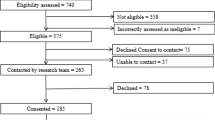Abstract
Anxiety symptoms are commonly described in children with chronic fatigue syndrome or myalgic encephalopathy (CFS/ME) but to date there has been little information on the type of anxiety children experience or the relationship between anxiety and school attendance, disability or fatigue. The aim of this study was to first describe the prevalence and type of anxiety symptoms in children with CFS/ME compared with a normal European population, and secondly to investigate the association of anxiety symptoms with age, gender, school attendance, fatigue, and physical function in paediatric CFS/ME. Data were prospectively collected on children and young people with CFS/ME referred to a large specialist CFS/ME service. One hundred and sixty-four children with CFS/ME had complete data for the Spence Children’s Anxiety Scale. Teenage girls had the highest rates of total anxiety symptoms with 38% (95% CI 27–49) over the cut off (top 10% of normal European population) and significantly higher rates of symptoms in each subscale. Younger girls were more likely to score over the cut off in separation anxiety (37%, 19–40) and social phobia (39%, 25–47). There was no evidence of association between total anxiety symptoms and: time at school, time to assessment, pain or age. Associations with fatigue and physical function were attenuated when adjusted for other variables. Although anxiety symptoms are high in CFS/ME, particularly in teenage girls, it does not appear to be associated with school attendance or other measures of disability. Separation anxiety and social phobia were the most clearly elevated in paediatric CFS/ME.
Similar content being viewed by others
Change history
25 May 2023
A Correction to this paper has been published: https://doi.org/10.1007/s00787-023-02224-6
References
Carter BD, Kronenberger WG, Edwards JF et al (1999) Psychological symptoms in chronic fatigue and juvenile rheumatoid arthritis. Pediatrics 103:975–979
Chalder T, Berelowitz G, Pawlikowska T et al (1993) Development of a fatigue scale. J Psychosom Res 37:147–153
Chalder T, Goodman R, Wessely S et al (2003) Epidemiology of chronic fatigue syndrome and self reported myalgic encephalomyelitis in 5–15 year olds: cross sectional study. Br Med J 327:654–655
Costello EJ, Mustillo S, Erkanli A et al (2003) Prevalence and development of psychiatric disorders in childhood and adolescence. Arch Gen Psychiatry 60:837–844
Dowsett EG, Colby J (1997) Long-term sickness absence due to ME/CFS in UK schools: an epidemiological study with medical and educational implications. J Chronic Fatigue Syndr 3:29–42
Garralda E, Chalder T (2005) Practitioner review: chronic fatigue syndrome in childhood. J Child Psychol Psychiatry. 46:1143–1151
Essau CA, Conradt J, Petermann F (2000) Frequency, comorbidity, and psychosocial impairment of anxiety disorders in German adolescents. J Anxiety Disord 14:263–279
Essau CA, Sakano Y, Ishikawa S et al (2004) Anxiety symptoms in Japanese and in German children. Behav Res Ther 42:601–612
Farmer A, Fowler T, Scourfield J et al (2004) Prevalence of chronic disabling fatigue in children and adolescents. Br J Psychiatry 184:477–481
Garralda E, Rangel L, Levin M et al (1999) Psychiatric adjustment in adolescents with a history of chronic fatigue syndrome. J Am Acad Child Adolesc Psychiatry 38:1515–1521
Garratt AM, Ruta DA, Abdalla MI et al (1993) The Sf-36 health survey questionnaire: an outcome measure suitable for routine use within the NHS. Br Med J 306:1440–1444
Jones JF, Nisenbaum R, Solomon L et al (2004) Chronic fatigue syndrome and other fatiguing illnesses in adolescents: a population-based study. J Adolesc Health 35:34–40
Jordan KM, Ayers PM, Jahn SC et al (2000) Prevalence of fatigue and chronic fatigue syndrome-like illness in children and adolescents. J Chronic Fatigue Syndr 6:3–21
Mellon RC, Moutavelis AG (2007) Structure, developmental course, and correlates of children’s anxiety disorder-related behavior in a Hellenic community sample. J Anxiety Disord 21:1–21
Muris P, Schmidt H, Merckelbach H (2000) Correlations among two self-report questionnaires for measuring DSM-defined anxiety disorder symptoms in children: the Screen for Child Anxiety Related Emotional Disorders and the Spence Children’s Anxiety Scale. Pers Individ Dif 28:333–346
National Institute for Health and Clinical Excellence (NICE) (2007) Chronic fatigue syndrome/myalgic encephalomyelitis (or encephalopathy); diagnosis and management, CG53
Patel MX, Smith DG, Chalder T et al (2003) Chronic fatigue syndrome in children: a cross sectional survey. Arch Dis Child 88:894–898
Rangel L, Garralda ME, Hall A et al (2003) Psychiatric adjustment in chronic fatigue syndrome of childhood and in juvenile idiopathic arthritis. Psychol Med 33:289–297
Richards J, Turk J, White S (2005) Children and adolescents with chronic fatigue syndrome in non-specialist settings: beliefs, functional impairment and psychiatric disturbance. Eur Child Adolesc Psychiatry 14:310–318
Rimes KA, Goodman R, Hotopf M et al (2007) Incidence, prognosis, and risk factors for fatigue and chronic fatigue syndrome in adolescents: a prospective community study. Pediatrics 119:e603–e609
Royal College of Paediatrics and Child Health (2004) Evidence based guideline for the management of CFS/ME (Chronic Fatigue Syndrome/Myalgic Encephalopathy) in Children and Young People, 2004, London
Silverman WK (2004) Separation anxiety disorder. In: Morris TL, March JS (eds) Anxiety disorders in children and adolescents. The Guilford Press, New York
Smith MS, Martin-Herz SP, Womack WM et al (2003) Comparative study of anxiety, depression, somatization, functional disability, and illness attribution in adolescents with chronic fatigue or migraine. Pediatrics 111:e376–e381
Spence SH (1998) A measure of anxiety symptoms among children. Behav Res Ther 36:545–566
Spence SH, Barrett PM, Turner CM (2003) Psychometric properties of the Spence Children’s Anxiety Scale with young adolescents. J Anxiety Disord 17:605–625
Van Middendorp H, Geenen R, Kuis W et al (2001) Psychological adjustment of adolescent girls with chronic fatigue syndrome. Pediatrics 107:E35
Viner R, Hotopf M (2004) Childhood predictors of self reported chronic fatigue syndrome/myalgic encephalomyelitis in adults: national birth cohort study. Br Med J 329:941
Acknowledgments
Thanks to the Linbury Trust for funding part of Dr Crawley’s salary, Mr Andrew Haig-Ferguson who was involved in data management and to the children and young people who were part of this study.
Author information
Authors and Affiliations
Corresponding author
Rights and permissions
About this article
Cite this article
Crawley, E., Hunt, L. & Stallard, P. Anxiety in children with CFS/ME. Eur Child Adolesc Psychiatry 18, 683–689 (2009). https://doi.org/10.1007/s00787-009-0029-4
Received:
Accepted:
Published:
Issue Date:
DOI: https://doi.org/10.1007/s00787-009-0029-4




